August Birth Flower ~ Gladiolus
August’s birth flower is gladiolus, or ‘sword lily.’ Gladiolus represents remembrance, calm, integrity, and infatuation. With gladiolus, the recipient’s heart is being “pierced with love.” The other August flower is the poppy. A red poppy signifies pleasure, a white poppy is given for consolation, and a yellow poppy wishes wealth and success.
See Also …
Gladiolus Plant Care Guide ~ Varieties

Gladiolus Plant Care Guide ~ Varieties
Gladiolus (from Latin, the diminutive of gladius, a sword) is a genus of perennial bulbous flowering plants in the iris family (Iridaceae).[1] It is sometimes called the ‘Sword lily’, but usually by its generic name (plural gladioli, gladioluses, glads).[2]
The genus is distributed in Mediterranean Europe, Asia, Tropical Africa and South Africa. The center of diversity of the genus is located in the Cape Floristic Region, where most species were discovered.[3] The genera Oenostachys, Homoglossum, Anomalesia and Acidanthera, traditionally considered independent entities, currently are included in Gladiolus.[4]
Species
The genus Gladiolus has been divided into many sections. Where possible, the sections have been indicated. Most species, however, are only tentatively placed.
- Gladiolus abbreviatus Andrews
- Gladiolus acuminatus F.Bol.
- Gladiolus aequinoctialis Herb.
- Gladiolus alatus L. (sect. Hebea)
- Gladiolus aleppicus Boiss. var. aleppicus
- Gladiolus anatolicus
- Gladiolus andringitrae Goldblatt
- Gladiolus angustus L. (sect. Blandus) : Long-tubed Painted Lady
- Gladiolus antandroyi Goldblatt
- Gladiolus antholyzoides Baker
- Gladiolus appendiculatus G.Lewis
- Gladiolus aquamontanus Goldblatt & Vlok
- Gladiolus arcuatus Klatt
- Gladiolus atropurpureus Baker
- Gladiolus atroviolaceus Boiss.
- Gladiolus aurantiacus Klatt
- Gladiolus aureus Baker : Golden Gladiolus
- Gladiolus bellus C. H. Wright
- Gladiolus benguellensis Baker (sect. Ophiolyza)
- Gladiolus bilineatus G. J. Lewis
- Gladiolus boehmii Vaupel (1882)
- Gladiolus bojeri (Baker) Goldblatt
- Gladiolus brachylimbus Baker (1893)
- Gladiolus brachyphyllus F. Bolus or Bolus f.
- Gladiolus brevifolius Jacq. (sect. Linearifolius)
- Gladiolus brevitubus G. Lewis
- Gladiolus buckerveldii (L. Bolus) Goldblatt
- Gladiolus bullatus Thunb. ex G. Lewis : Caledon Bluebell
- Gladiolus caeruleus Goldblatt & J.C. Manning
- Gladiolus calcaratus G. Lewis
- Gladiolus calcicola Goldblatt
- Gladiolus canaliculatus Goldblatt
- Gladiolus candidus (Rendle) Goldblatt
- Gladiolus cardinalis Curtis (sect. Blandus)
- Gladiolus carinatus Aiton
- Gladiolus carmineus C. H. Wright (sect. Blandus) : Cliff Lily
- Gladiolus carneus (sect. Blandus) : Large Painted Lady
- Gladiolus caryophyllaceus (Burm. f.) Poiret
- Gladiolus cataractarum Oberm.
- Gladiolus caucasicus Herb.
- Gladiolus ceresianus L. Bolus
- Gladiolus citrinus Klatt
- Gladiolus x colvillei : Colville’s Gladiolus
- Gladiolus communis L. (sect. Gladiolus) : Cornflag (type species)
- Gladiolus communis subsp. byzantinus (sect. Gladiolus) – Whistling Jack, Eastern Gladiolus
- Gladiolus communis subsp. communis (sect. Gladiolus)
- Gladiolus conrathii Baker (1898)
- Gladiolus crassifolius Baker
- Gladiolus crispulatus L. Bolus
- Gladiolus cruentus T. Moore (sect. Ophiolyza)
- Gladiolus curtifolius Marais
- Gladiolus cuspidatus
- Gladiolus cylindraceus G. Lewis
- Gladiolus cymbarius Baker
- Gladiolus dalenii Van Geel (sect. Ophiolyza)
- Gladiolus debilis Ker Gawler (sect. Homoglossum) : Small Painted Lady
- Gladiolus decaryi Goldblatt
- Gladiolus decipiens Vaupel
- Gladiolus decoratus Baker
- Gladiolus delpierrei Goldblatt
- Gladiolus densiflorus Baker
- Gladiolus deserticolus Goldblatt
- Gladiolus dolomiticus Oberm.
- Gladiolus dracocephalus Hook.f.
- Gladiolus dregei Klatt
- Gladiolus dubius
- Gladiolus dzavakheticus
- Gladiolus ecklonii Lehm.
- Gladiolus edulis Burchell ex Ker Gawler
- Gladiolus elliotii Baker (sect. Ophiolyza)
- Gladiolus emiliae L. Bolus
- Gladiolus engysiphon G. Lewis
- Gladiolus equitans Thunb. (sect. Hebea)
- Gladiolus erectiflorus Baker
- Gladiolus exiguus G. Lewis
- Gladiolus flanaganii Baker : : Suicide Gladiolus
- Gladiolus floribundus Jacq.
- Gladiolus fourcadei (L.Bolus) Goldblatt & M.P.de Vos
- Gladiolus ×gandavensis (sect. Ophiolyza) [= G. dalenii × ‘G. oppositiflorus]
- Gladiolus garnierii Klatt
- Gladiolus geardii L. Bolus
- Gladiolus goetzii Harms
- Gladiolus gracilis Jacq. (sect. Homoglossum) : Reed Bells
- Gladiolus gracillimus Baker
- Gladiolus grandiflorus (sect. Blandus)
- Gladiolus gregarius Welw. ex Baker (sect. Densiflorus)
- Gladiolus griseus Goldblatt & J.C. Manning
- Gladiolus gueinzii Kunze
- Gladiolus guthriei F. Bol. (sect. Linearifolius)
- Gladiolus halophilus Boiss. & Heldr.
- Gladiolus harmsianus Vaupel
- Gladiolus heterolobus Vaupel
- Gladiolus hirsutus Jacq. (sect. Linearifolius) : Small Pink Afrikaner
- Gladiolus hollandii L. Bolus
- Gladiolus horombensis Goldblatt
- Gladiolus huillensis (Welw. ex Baker) Goldblatt
- Gladiolus hyalinus Jacq.
- Gladiolus illyricus W.D.J.Koch – Wild Gladiolus
- Gladiolus imbricatus L.
- Gladiolus inandensis Baker
- Gladiolus incospicuus Baker
- Gladiolus inflatus Thunb.
- Gladiolus inflexus Goldblatt & J.C. Manning
- Gladiolus insolens Goldblatt & J.C. Manning
- Gladiolus intonsus Goldblatt
- Gladiolus invenustus G. J. Lewis
- Gladiolus involutus (sect. Hebea)
- Gladiolus iroensis (A. Chev.) Marais
- Gladiolus italicus P. Mill. (sect. Gladiolus) – Italian Gladiolus, Cornflag
- Gladiolus johnstoni Baker (s. d.)
- Gladiolus jonquilliodorus Ecklon ex G. Lewis
- Gladiolus junodi Baker
- Gladiolus kamiesbergensis G. Lewis
- Gladiolus karendensis Baker
- Gladiolus katubensis De Wild.
- Gladiolus klattianus Hutch.
- Gladiolus kotschyanus Boiss.
- Gladiolus kubangensis Harms
- Gladiolus lapeirousioides Goldblatt
- Gladiolus laxiflorus Baker
- Gladiolus lemoinei
- Gladiolus leptosiphon Bolus f.
- Gladiolus liliaceus Houtt. (sect. Homoglossum)
- Gladiolus linearifolius Vaupel
- Gladiolus linearis N.E.Br.
- Gladiolus longanus Harms
- Gladiolus longicollis Baker (sect. Homoglossum)
- Gladiolus longicollis subsp. longicollis (sect. Homoglossum)
- Gladiolus longicollis subsp. platypetalus (sect. Homoglossum)
- Gladiolus loteniensis Hilliard & Burtt
- Gladiolus louiseae L. Bolus
- Gladiolus lundaensis Goldblatt
- Gladiolus luteus Lam.
- Gladiolus lyalinus
- Gladiolus macneilii Oberm.
- Gladiolus macowani Baker
- Gladiolus macowanii Baker (s. d.)
- Gladiolus macrospathus Goldblatt
- Gladiolus maculatus Sweet
- Gladiolus magnificus (Harms) Goldblatt
- Gladiolus malangensis Baker (1879)
- Gladiolus malvinus Goldblatt & J.C. Manning
- Gladiolus marlothii G. Lewis
- Gladiolus martleyi L. Bolus (sect. Homoglossum)
- Gladiolus meliusculus (G. Lewis) Goldblatt & J.C. Manning
- Gladiolus melleri Baker (sect. Ophiolyza)
- Gladiolus micranthus Baker (1901)
- Gladiolus microcarpus G. Lewis
- Gladiolus microsiphon Baker
- Gladiolus milleri Ker Gawler
- Gladiolus mirus Vaupel
- Gladiolus monticola G. Lewis ex Goldblatt & J.C. Manning
- Gladiolus mortonius (sect. Densiflorus)
- Gladiolus mostertiae L. Bolus
- Gladiolus muenzneri F. Vaup
- Gladiolus murielae Kelway (syn. G. callianthus) – Abyssinian Gladiolus
- Gladiolus natalensis (Eckl.) Hook.
- Gladiolus nerineoides G. Lewis
- Gladiolus newii Baker
- Gladiolus nigromontanus Goldblatt
- Gladiolus niveus Goldblatt & J.C. Manning
- Gladiolus nyasicus Goldblatt
- Gladiolus oatesii Rolfe
- Gladiolus ochroleucus Baker (sect. Densiflorus)
- Gladiolus odoratus L. Bolus
- Gladiolus oliganthus Baker
- Gladiolus oppositiflorus Herbert (sect. Ophiolyza)
- Gladiolus orchidiflorus Andrews (sect. Hebea)
- Gladiolus oreocharis Schltr.
- Gladiolus pallidus Baker
- Gladiolus paludosus Baker
- Gladiolus palustris : Marsh Gladiolus
- Gladiolus papilio Hook. f. (sect. Densiflorus) : Goldblotch Gladiolus
- Gladiolus pappei Baker (sect. Blandus)
- Gladiolus pardalinus Goldblatt & J.C. Manning
- Gladiolus parvulus Schltr.
- Gladiolus patersoniae F. Bolus or Bolus f.
- Gladiolus pavonia Goldblatt & J.C. Manning
- Gladiolus permeabilis Delaroche (sect. Hebea)
- Gladiolus perrieri Goldblatt
- Gladiolus persicus Boiss.
- Gladiolus pillansii G. Lewis
- Gladiolus pole-evansii Verd.
- Gladiolus praecostatus
- Gladiolus praelongitubus G. J. Lewis
- Gladiolus pretoriensis Kuntze
- Gladiolus priorii (N. E. Br.) Goldblatt & De Vos
- Gladiolus prismatosiphon Schltr.
- Gladiolus pritzelii Diels
- Gladiolus psittacinus Hook.
- Gladiolus puberulus Vaupel
- Gladiolus pubigerus G. Lewis
- Gladiolus pulchellus Klatt
- Gladiolus pulcherrimus (G. Lewis) Goldblatt & J.C. Manning
- Gladiolus punctulatus Schrank
- Gladiolus pusillus Goldblatt
- Gladiolus quadrangularis (Burm. f.) Ker Gawler
- Gladiolus quadrangulus (Delaroche) Barnard
- Gladiolus ramosus
- Gladiolus recurvus (sect. Homoglossum)
- Gladiolus rehmannii Baker
- Gladiolus remotifolius Baker
- Gladiolus rigidifolius Baker
- Gladiolus robertsoniae F. Bolus or Bolus f.
- Gladiolus rogersii Baker
- Gladiolus roseovenosus Goldblatt & J.C. Manning
- Gladiolus rubellus Goldblatt
- Gladiolus rudis Lichtst. ex Roem. & Schult.
- Gladiolus rupicola F. Vaupel
- Gladiolus saccatus (Klatt) Goldblatt & M.P. de Vos
- Gladiolus salteri G. Lewis
- Gladiolus saundersii Hook. f. : Saunders’ Gladiolus, Lesotho Lily
- Gladiolus schlechteri Baker
- Gladiolus schweinfurthii Baker
- Gladiolus scullyi Baker
- Gladiolus serapiiflorus Goldblatt
- Gladiolus serenjensis Goldblatt
- Gladiolus sericeovillosus Hook. f.
- Gladiolus serpenticola Goldblatt & J.C. Manning
- Gladiolus somalensis Goldblatt & Thulin
- Gladiolus speciosus Thunb.
- Gladiolus spectabilis Baker (s. d.)
- Gladiolus splendens ((Sweet)) Herbert
- Gladiolus stefaniae Oberm.
- Gladiolus stellatus G. Lewis
- Gladiolus subcaeruleus G. Lewis
- Gladiolus sufflavus (G. Lewis) Goldblatt & J.C. Manning
- Gladiolus sulcatus Goldblatt
- Gladiolus taubertianus Schltr.
- Gladiolus tenellus Ecklon
- Gladiolus tenuis M. Bieb.
- Gladiolus teretifolius Goldblatt & De Vos
- Gladiolus thomsonii Baker
- Gladiolus trichonemifolius (sect. Homoglossum)
- Gladiolus tristis (sect. Homoglossum)
- Gladiolus tristis var. concolor (Salisb.) Baker : Ever-flowering Gladiolus
- Gladiolus tritoniaeformis
- Gladiolus tritoniiformis Kuntze
- Gladiolus uitenhagensis Goldblatt & Vlok
- Gladiolus undulatus L. (sect. Blandus) : Waved-flowered Gladiolus
- Gladiolus unguiculatus Baker
- Gladiolus usambarensis Marais ex Goldblatt
- Gladiolus uysiae L. Bolus ex G. Lewis
- Gladiolus vaginatus F. Bolus or Bolus f. (sect. Homoglossum)
- Gladiolus validissimus Vaupel
- Gladiolus vandermerwei (L. Bolus) Goldblatt & De Vos
- Gladiolus varius F. Bolus or Bolus f.
- Gladiolus velutinus De Wild.
- Gladiolus venustus G. Lewis (sect. Hebea)
- Gladiolus vernus Oberm.
- Gladiolus vinoso-maculatus Kies
- Gladiolus violaceo-lineatus G. Lewis
- Gladiolus virescens Thunb. (sect. Hebea)
- Gladiolus viridiflorus G. Lewis
- Gladiolus viridis Aiton
- Gladiolus watermeyeri (sect. Hebea)
- Gladiolus watsonioides Baker : Mackinder’s gladiolus
- Gladiolus watsonius Thunb. (sect. Homoglossum)
- Gladiolus woodii Baker
- Gladiolus zimbabweensis Goldblatt
************************

Botanical name: Gladiolus @ Old Farmer’s Almanac
Plant type: Flower
USDA Hardiness Zones: 6, 7, 8, 9, 10
Sun exposure: Full Sun
Soil type: Any
Flower color: Red, Pink, Orange, Yellow, White, Multicolor
Bloom time: Summer
Gladiolus is a perennial favored for its beautiful, showy flowers. Its flowers grow on tall spikes and are often found in cutting gardens or in the back along the border (because they are tall). Gladioli have many different colored flowers, and grow between 2 to 6 feet in height. It’s good for cut flowers.
Planting
- Plant gladiolus bulbs in the spring once danger of frost has passed and the soil has warmed.
- Ready your garden by using a garden fork or tiller and loosen the soil to about 12 to 15 inches deep. After loosening the soil, mix in a 2– to 4–inch layer of compost.
- Plant your bulbs 4 to 8 inches deep with the pointed end facing up. Space the corms 3 to 6 inches apart. Water the corms thoroughly.
- Gladioli like well-drained, light soil and full sun.
- If you’re planting tall varieties, be sure to stake them at planting time. Be careful not to damage the corms with the stakes.
- It takes about 90 days from the time gladioli are planted to root, grow, bloom, and store enough energy for the next season.
Care
- Put a 2– to 4–inch layer of mulch around your gladioli to keep your soil moist and help prevent weeds.
- If you get less than 1 inch of rain a week, water your plants regularly throughout the summer. Otherwise, water them moderately when in growth to keep the soil moist.
- Remove the faded/dead flowers to ensure continuous growth. Once all the flowers on a stalk have gone, cut off the stalk.
- Be sure to leave the plant intact so it can mature and rejuvenate the corms for the next season.
- If you live in zones 7 or 8, put down a layer of hay or straw for winter protection.
- Corms should be dug before the last frost in you live in zone 7 or ones colder.
Pests
Harvest/Storage
- At the end of the season, cut the stalks to within an inch of the corms, then leave them in a warm, airy location for 1 to 2 weeks.
- Remove and throw away the oldest bottom corms and store the new corms in plastic, mesh bags in a well–ventilated room. The temperature of the room should be between 35º and 45ºF. Replant these corms in the spring.
Recommended Varieties
- Candyman, for its beautiful deep pink flowers
- Dream’s End, which makes a good back border plant because its flower spike is up to 3 feet long (and it has pretty light orange flowers with large yellow centers)
- Prins Claus, which has white flowers with splashes of pink on its petals
******************
See Also …
Gladiolus Planting Guide
Gladiolus @ National Gardening Association
GROWING GLADIOLUS


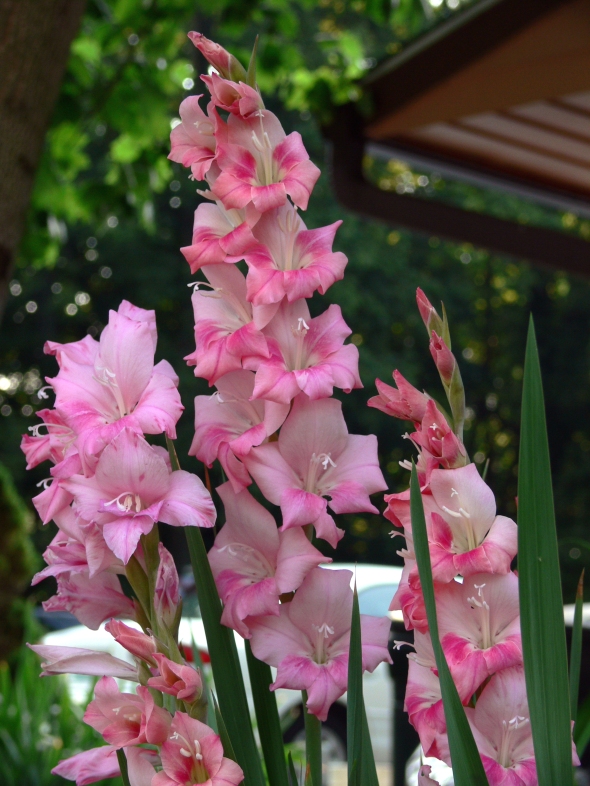

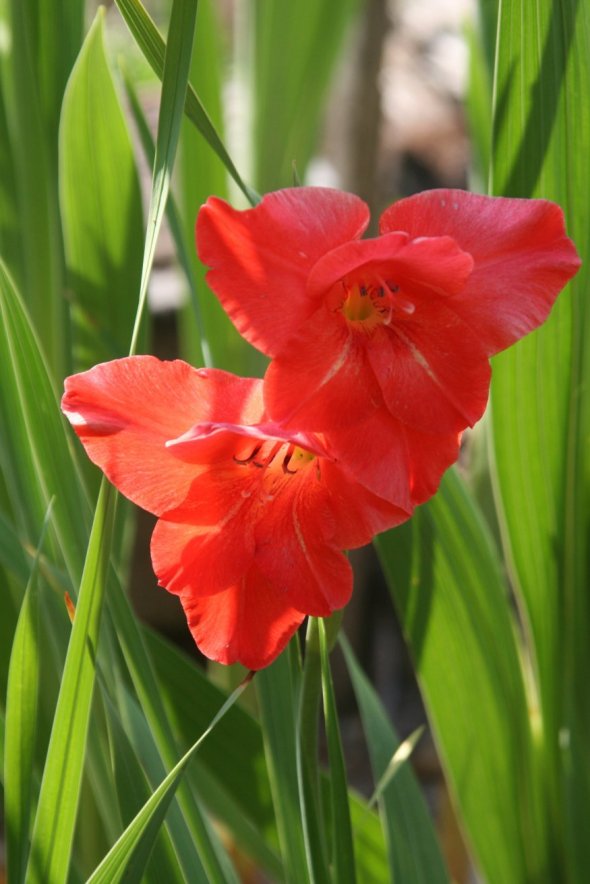

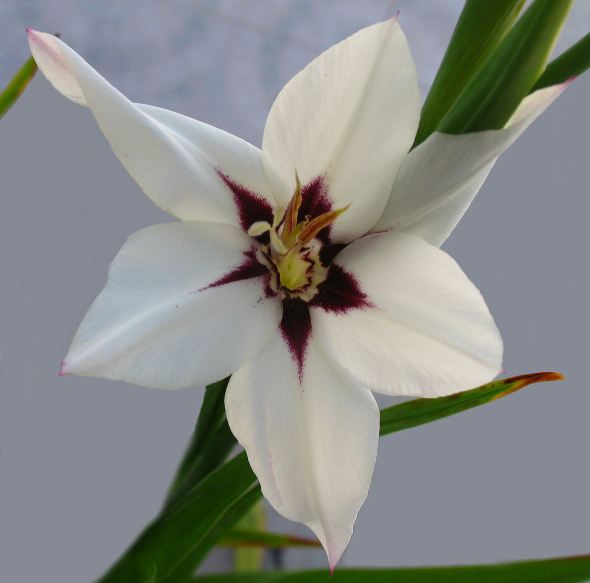

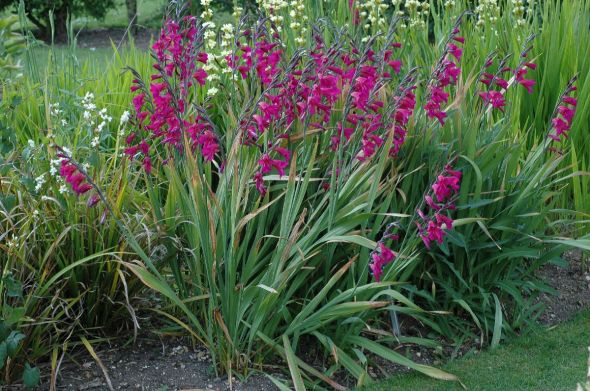
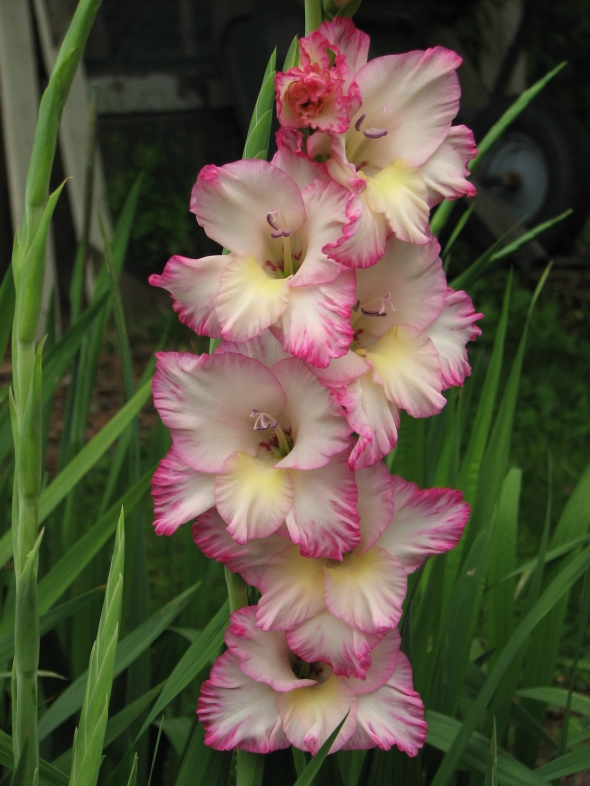




Recent Comments